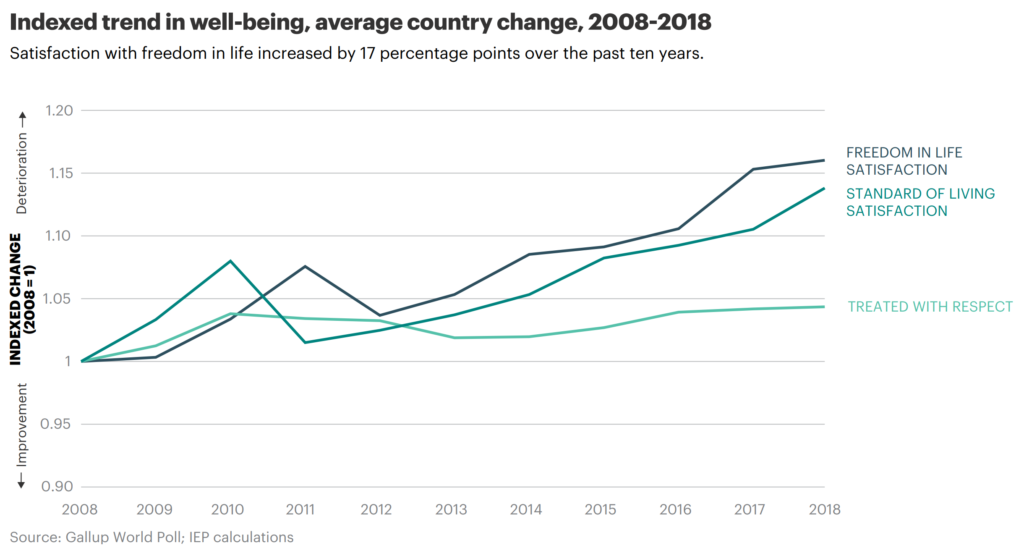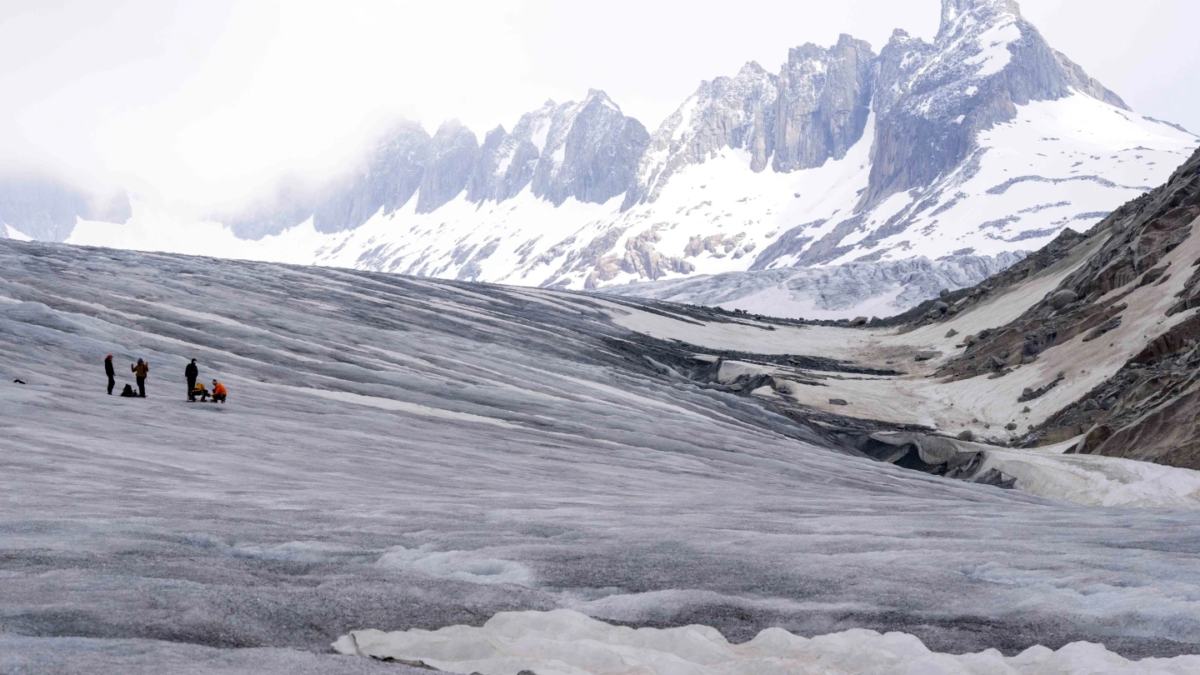Global peacefulness improves for first time in five years, but world still less peaceful than a decade ago
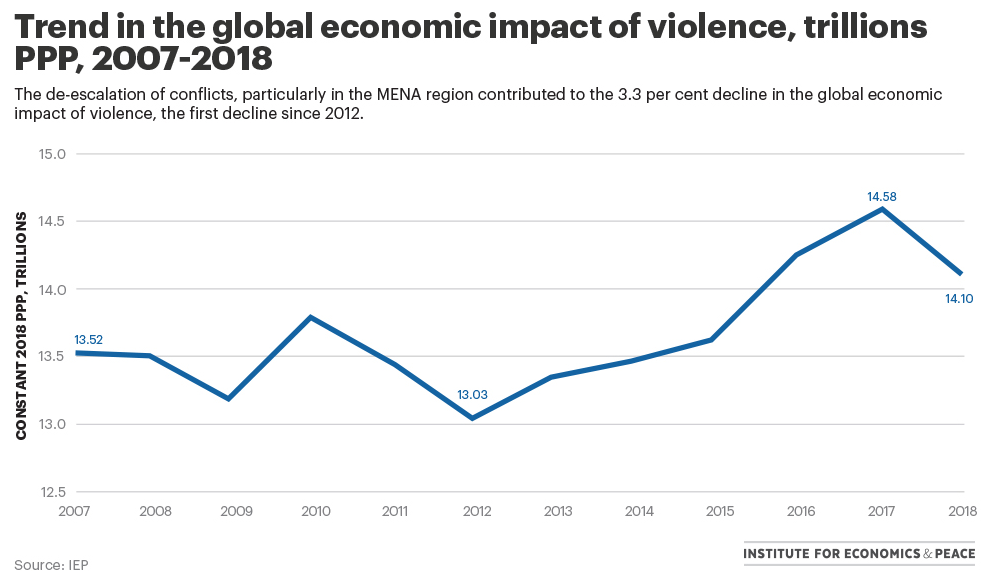
12 June 2019 (IEP) – The 13th edition of the annual Global Peace Index (GPI) report, the world’s leading measure of global peacefulness, reveals that the average level of global peacefulness improved for the first time in five years. However, despite improvement, the world remains considerably less peaceful now than a decade ago, with the average level of peacefulness deteriorating by nearly four per cent since 2008. This year’s report includes new research on the possible effects of climate change on peace.
Key Results
- Ukraine registered the largest improvement in peacefulness this year; Nicaragua the largest drop.
- More countries decreased their militarisation, 106 countries, than increased it – continuing a decade long trend.
- Since 2008 global peacefulness has deteriorated by 3.78 per cent, with 81 countries deteriorating and 81 improving, highlighting that deteriorations in peacefulness are generally larger than improvements.
Climate Change Highlights
- More than 400 million people live in areas with low levels of peacefulness and high risk from climate change.
- Eight of the 25 least peaceful countries have 103 million at risk in high climate hazard areas.
- Regionally, sub-Saharan Africa has the weakest coping capacity for climate hazards, which could exacerbate violent conflicts.
GDP/Economic Cost of Violence Highlights
- The economic impact of violence on the global economy has decreased for the first time since 2012, amounting to $14.1 trillion in 2018, or 11.2 per cent or $1,853 for every person.
- Countries with very high levels of peace, on average, achieved over three times higher per capita GDP growth compared to the least peaceful countries for the last 60 years.
- In the ten countries most affected by violence, the average economic cost of violence was equivalent to 35 per cent of GDP, compared to just 3.3 per cent in the countries least affected by violence.
Eighty-six countries improved their score in the 2019 report, whilst 76 deteriorated. Iceland remains the most peaceful country in the world, a position it has held since 2008. It is joined at the top of the index by New Zealand, Austria, Portugal, and Denmark. Bhutan has recorded the largest improvement of any country in the top 20, rising 43 places in the last 12 years.
Afghanistan is now the least peaceful country in the world, replacing Syria, which is now the second least peaceful. South Sudan, Yemen, and Iraq comprise the remaining five least peaceful countries. This is the first year since the inception of the index that Yemen has been ranked amongst the five least peaceful countries.
Steve Killelea, Founder and Executive Chairman of the IEP, said: “Although peace has improved in the 2019 GPI, a deeper analysis finds a mixture of positive and negative trends.”
Four of the nine regions in the world became more peaceful over the past year. The largest increase in peacefulness occurred in the Russia and Eurasia region, followed by the Middle East and North Africa. In both regions, the number of deaths from conflict declined in Ukraine and Syria respectively. The fall in conflict deaths has been mirrored by a fall in deaths from terrorism.
Two of the three GPI domains deteriorated over the past decade, with Ongoing Conflict deteriorating by 8.7 per cent and Safety and Security deteriorating by 4 per cent. However, contrary to public perception, the Militarisation domain has recorded a 2.6 per cent improvement since 2008. The number of armed services personnel per 100,000 people has fallen in 117 countries, and military expenditure as a percentage of GDP fell in 98 countries, with only 63 countries increasing their spending.
The GPI report presents the most comprehensive data-driven analysis to-date on peace, its economic value, trends, and how to develop peaceful societies. The report covers 99.7 per cent of the world’s population and uses 23 qualitative and quantitative indicators from highly respected sources to compile the index. These indicators are grouped into three key domains: Ongoing Conflict, Safety and Security, and Militarisation.
Global peacefulness improves for the first time in five years
Global Peace Index 2019
12 June 2019 (IEP) – The average level of global peacefulness improved very slightly last year on the 2019 Global Peace Index (GPI). This was the first time that the index improved in the last five years. The average country score improved by -0.09 per cent, with 86 countries improving and 76 recording deteriorations.
Iceland remains the most peaceful country in the world, a position it has held since 2008. It is joined at the top of the index by New Zealand, Austria, Portugal, and Denmark. Bhutan has recorded the largest improvement of any country in the top 20, rising 43 places in the last 12 years.
Afghanistan is now the least peaceful country in the world, replacing Syria, which is now the second least peaceful. South Sudan, Yemen, and Iraq comprise the remaining five least peaceful countries. This is the first year since the inception of the index that Yemen has been ranked amongst the five least peaceful countries.
Four of the nine regions in the world improved in peacefulness in 2019: Russia and Eurasia, Asia-Pacific, Europe, and the Middle East and North Africa (MENA). Europe maintained its position as the most peaceful region in the world, which it has held for every year of the GPI. MENA remained the least peaceful region for the fifth year in a row, although it did become more peaceful last year.
While most of Russia and Eurasia remains less peaceful than the global average, it showed the largest regional improvement. Central America and the Caribbean had the largest regional deterioration.
Despite the improvement this year, the world remains considerably less peaceful now than a decade ago, with the average level of peacefulness deteriorating by 3.78 per cent since 2008. Global peacefulness has only improved for three of the last ten years. A wide range of factors drove the fall in peacefulness over the past decade including increased terrorist activity, the intensification of conflicts in the Middle East, rising regional tensions in Eastern Europe and northeast Asia, increasing numbers of refugees, and heightened political tensions in Europe and the US.
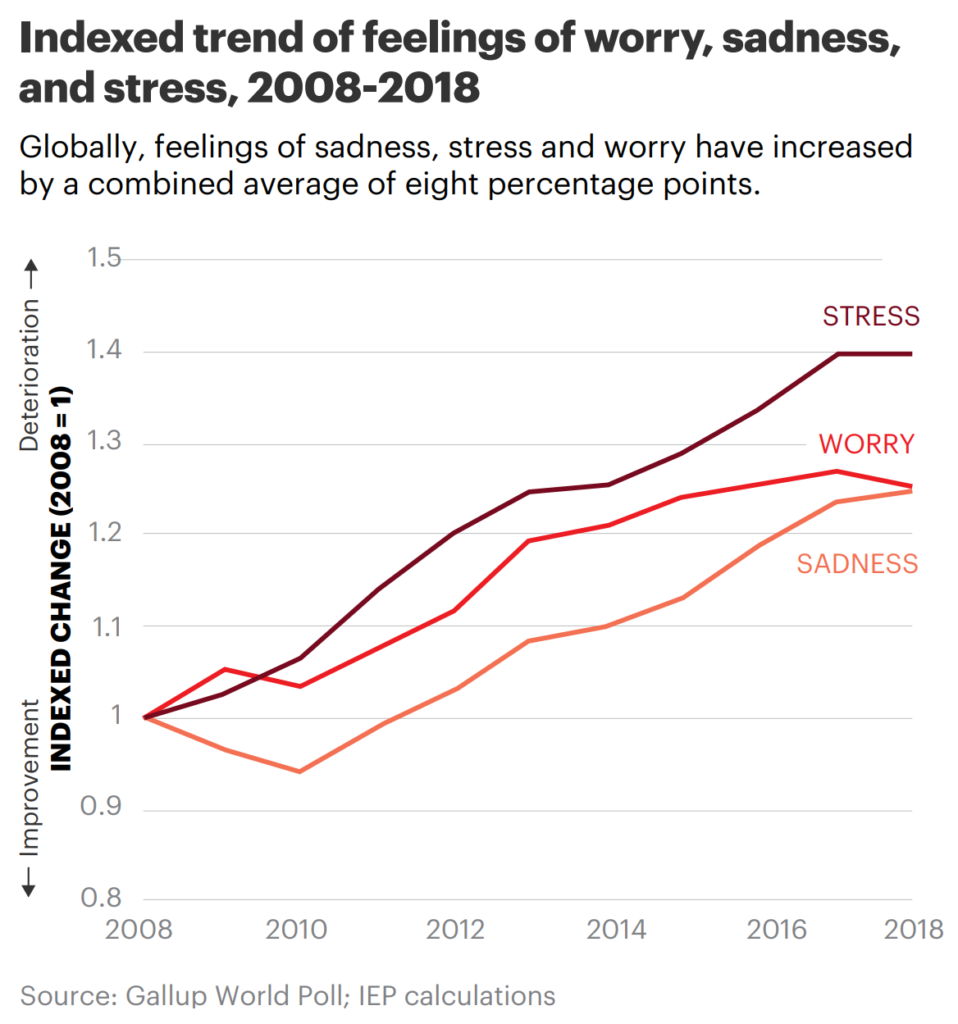
This deterioration was partially offset by improvements in many of the measures of the Militarisation domain of the GPI. There has been a consistent reduction in military expenditure as a percentage of GDP for the majority of countries, as well as a fall in the armed services personnel rate for most countries in the world.
The economic impact of violence on the global economy in 2018 amounted to $14.1 trillion in constant purchasing power parity (PPP) terms. This is equivalent to 11.2 per cent of the world’s GDP or $1,853 per person.
In 2018, the economic impact of violence improved for the first time since 2012, decreasing by 3.3 per cent or $475 billion. The decline in the economic impact of violence is reflective of the improvement in global peacefulness, which is discussed in section one of this report.
The reduction was primarily due to a decline in the costs associated with Armed Conflict. This improvement was mainly due to lower levels of armed conflict in Syria, Colombia and Ukraine. This also resulted in a positive knock-on effect for refugees and internally displaced persons and terrorism, with reductions in the costs for both.
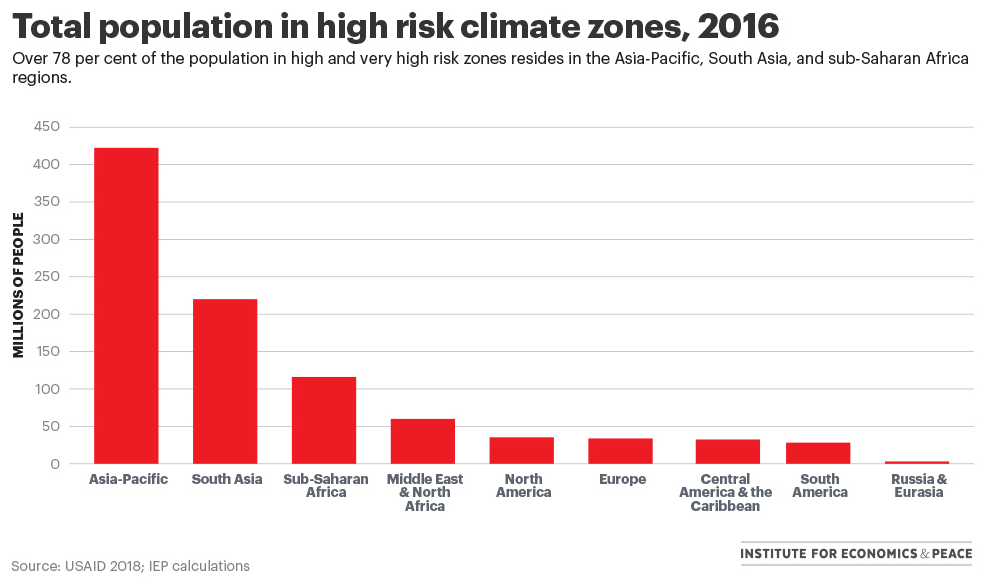
For the first time, the GPI 2019 includes research on climate change and peace. The impacts of fluctuating climate conditions on societal stability and its potential to lead to violent conflict is of growing importance. Although long-term quantitative data on the interactions of climate and peace is scarce, what is available suggests that climate has played a role in triggering or exacerbating conflict through its effects on livelihood security and resource availability.
The effects of climate shocks on factors such as resource scarcity, livelihood security and displacement can greatly increase the risk of future violent conflict, even when climate change does not directly cause conflict.
An estimated 971 million people live in areas with high or very high exposure to climate hazards, putting them at risk for both extreme weather events and breakdowns in peacefulness in the coming decades. Of this number, 41 per cent reside in countries with low levels of peacefulness, while 22 per cent are in countries with high levels of peace.
The Asia-Pacific and South Asia regions collectively house twice as many people in high exposure climate zones as all other regions combined. A risk assessment carried out by the Index for Risk Management in 2019 found that South Asia, Asia-Pacific and Central America and the Caribbean have weaker coping capacities and higher risk to natural hazards as compared to other regions.

The GPI 2019 also includes new data on wellbeing and perceptions of peacefulness. The reports shows that there have been increases in average feelings of life satisfaction and wellbeing, perceptions of safety, and confidence in the local police and military, despite the last decade showing a decline in peacefulness around the world.
Perceptions of peacefulness have increased in some areas but decreased in others. More people across the world now feel that they have more freedom in life, are more satisfied with life, and are treated with more respect than in 2008. Many more people also feel that their countries are better places to live for ethnic and religious minorities. However, daily feelings of sadness, worry, and stress have also increased over the same time.
There is a strong correlation between perceptions of peacefulness and actual peacefulness as measured by the GPI. Both men and women in more peaceful countries are more likely to report that they feel safe walking alone at night than people in less peaceful countries. There is also a greater level of trust in police in more peaceful societies.
For the complete analysis, download the Global Peace Index.

